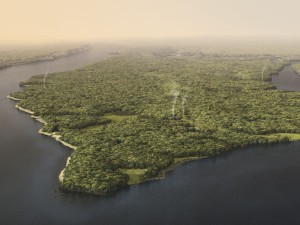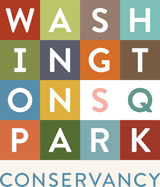Remembering Our History: The First Villagers

Illustration by Markley Boyer
Long before the Arch and the Fountain, before it was a potter’s field or farmland, before Dutch settlements were built, the land of Washington Square Park was wild. It was a lush marshland teeming with plant and animal life. To the west and running south of where the Arch now stands flowed one of the largest natural watercourses in Manhattan: Minetta Creek, which may have come from the name Manette meaning Devil’s Water in a Native American language.
This idyllic spot was a home for more than wildlife, it was peopled by the Lenape. The Lenape are sometimes confused for a single tribe, but in reality they were related groups, broken down into smaller tribes, who spoke similar languages and shared family ties. The Lenape spoke either the Unami or Munsee languages and differentiated depending on which language one spoke. A Lenape would have identified first with immediate family, clan and village, then with neighboring villages, then with more distant Lenape who spoke the same dialect, and finally with all Lenape people.
The Lenape who spent time in Lower Manhattan would migrate between a number of seasonal camps across Manhattan, Westchester, northern New Jersey, and western Long Island. What we now call Greenwich Village was one such camp, known by the name Sappokanican, which roughly translates to the “Land of Tobacco growth.” Farming was an important part of Lenape life, although they did not conceive of private land ownership. The land belonged to families within the clan collectively while it was inhabited and until they moved on to a new campsite as resources and seasons dictated.
The Lenape lived peacefully with the Dutch when they first settled in Lower Manhattan in 1624, but it was not to last. The story goes that in 1626 the Lenape “sold” Manhattan to the Director of the settlement, Peter Minuit, for the price of 60 guilders. That would have been about $24 at the time. However, due to the Lenape’s understanding of land “ownership,” they would have seen it as granting the Dutch a chance to share the land together. There is no hard evidence to prove that this interaction happened, and it’s been a point of contention for historians.
What we do know is that the Dutch took ownership of the land in a very European sense of the word. Conflicts between the Lenape and the Dutch increased as settlers laid claim to the land. Many Lenape were killed by diseases brought over by Europeans. There was no respite for the Lenape even when the English acceded to power in the 1664ーchanging New Amsterdam to New Yorkー By the early 1700s the few hundred who managed to survive the European invasion were forced to leave Manhattan.
It isn’t only at Thanksgiving that we should acknowledge the first stewards of the beautiful land we now call Washington Square Park, but it’s certainly a good reminder. Although much has changed since its beginnings as a marsh, we can still have respect for where we stand and appreciate the beauty that can be found there still.
